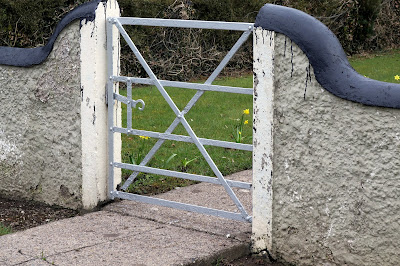Tidy Towns gates project
 |
| Convent field gate recently refurbished by GAA. |
"These gates appear to have been forgotten but with a little work they will become focal points around the town again," says Ray Kelly, chairman of the Tidy Towns umbrella group KCA.
Apart from controlling access to fields, gardens and homes, gates also have a heritage aspect. The materials they're made from — wood, old blacksmith’s iron, farm-gate tubular steel and back to modern forged iron — represent not just changing technologies and tastes, but also a variety of crafts-working skills.
There have always been generational changes in styles of gates, especially in those used for houses, and the 1939 Nicholastown housing estate shows that very clearly. Built in a time when cars were not in general ownership, original access to each home was through a narrow front gate designed just for people. But in post-WW2 Kilcullen many householders made space on the generously-sized sites for cars, which usually meant opening a secondary wide gate. The opportunity to change the original gates was often taken then, and over the decades the original design has often been cast aside.
As a young lad in the 50s playing with friends up in Nicholastown, I remember well the original gates, because most of the homes still had them. I took a walk around the area last week, and found that there are now only three examples (pictured above) of the original design in existence. Ray Kelly has a drawing in his blacksmith grandfather John ffrench's notebook of the original style, designed and forged locally.
There are quite a few other old gates still around. The one into what was the Convent Field is an example, recently cleaned and painted during the excellent clean-up work undertaken by Kilcullen GAA around its training pitch.
Iconic gates include the original Cross and Passion ones on the crossroads corner — realigned in 1985 — and those on the same property opposite the Garda Station. Both at the moment would benefit from a little TLC.
There’s also the old 18th century and well-maintained gates at Castlemartin Stud, which we are fortunate to have to remind of a heritage location which has seen much history, both tranquil and turbulent through centuries.
Throughout the town itself are some small and large examples of gates which shouldn’t ever be replaced simply because they’re scruffy and rusted. They have stories behind them, and even if they can’t tell those stories themselves they do serve as aide-memoires along Kilcullen’s timeline.
It’s nice to see a focus on cleaning and painting some of them. It might seem a small thing, but the heritage we have today is built on thousands of small things created and left to us by very many people who have lived in Kilcullen or who in some cases have only passed through.
It's good not to just replace everything for the sake of modernity, as we ourselves pass through.
(Picture credits: Brian Byrne, Ray Kelly, and Castlemartin gate from Public domain repository burningwell.org.)







































